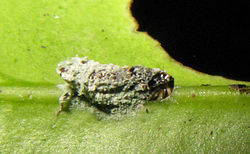- Metarhizium flavoviride
-
Metarhizium flavoviride 
Unidentified leafhopper (Cicadellidae) infected with M. flavoviride: Atewa forest, Ghana (2008) Scientific classification Kingdom: Fungi Subkingdom: Dikarya Phylum: Ascomycota Class: Sordariomycetes Order: Hypocreales Family: Clavicipitaceae Genus: Metarhizium Species: M. flavoviride Binomial name Metarhizium flavoviride
Gams & Roszypal, 1973Metarhizium flavoviride is the name given to a group of fungal isolates that are known to be virulent against Hemiptera and some Coleoptera. Spores (conidia) are light grey-green and oval-shaped (approximately 7-11 µm long)[1].
As with other Metarhizium species, there has been interest in developing isolates into mycoinsecticides: with work carried out on rice insect pests during the 1970-80s[2]. However, such isolates appear to be more difficult to mass produce, so there has been less commercial activity than with other Metarhizium species. In light of new molecular techniques, we now know that references to this species for control of locusts (e.g. in early LUBILOSA Programme literature) should apply to Metarhizium acridum.
References
- ^ Humber RA. 1997. Fungi: identification. In: Manual of techniques in insect pathology. San Diego, California (USA): Academic Press Inc. p 153-185.
- ^ Shepard BM, Barrion AT, Litsinger JA. 1987. Helpful insects, spiders, and pathogens. Manila (Philippines): International Rice Research Institute. 127 pp.
See also
Categories:- Hypocreales
- Parasitic fungi
- Hypocreales stubs
Wikimedia Foundation. 2010.
